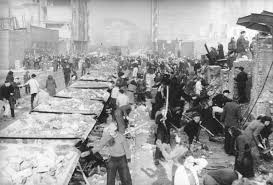“Rebuilding Europe After World War II” – Everything You Need to Know
The aftermath of World War II left Europe in ruins—cities decimated, economies shattered, and millions displaced. Yet, from the devastation emerged one of the most remarkable recovery efforts in modern history. In this comprehensive guide on Rebuilding Europe After World War II, we’ll explore how nations rose from the ashes of conflict, the innovative policies and international cooperation that spurred recovery, and the enduring legacy of this transformation. Whether you’re a history student, a policy maker, or simply curious about how Europe reinvented itself, this post will provide you with a detailed and engaging overview of why the post-war rebuilding effort is a critical chapter in our shared global history.
Introduction: From Ruins to Renaissance
Imagine walking through cities that, just a few short years earlier, lay in rubble and despair. By the 1950s and 1960s, Europe had not only rebuilt its physical infrastructure but had also reimagined its economic, political, and social landscapes. Did you know that the Marshall Plan—an American initiative providing over $12 billion (equivalent to more than $100 billion today) in economic aid—played a pivotal role in sparking Europe’s recovery? In this article on Rebuilding Europe After World War II, we will cover:
- Definition & Core Characteristics: What “rebuilding Europe” means and the essential elements that defined this massive recovery effort.
- Historical Background: Key events and milestones from the end of World War II through the post-war reconstruction period.
- In-Depth Exploration: Detailed analysis of political reforms, economic recovery programs, social changes, and cultural renaissances that took place during this era.
- Importance & Applications: How the lessons from Europe’s post-war recovery continue to influence modern economic policy, international cooperation, and social development.
- Common Misconceptions & FAQs: Addressing myths and clarifying misunderstandings about the rebuilding process.
- Modern Relevance: How this period continues to impact contemporary Europe and global affairs.
- Call-to-Action: Encouraging further reading, discussion, and engagement with this pivotal historical transformation.
Understanding Rebuilding Europe After World War II is not only about acknowledging the past—it’s about drawing lessons that help guide our future. The remarkable recovery of Europe shows how innovative policies, international collaboration, and human resilience can overcome even the most devastating crises.
What Is “Rebuilding Europe After World War II”?
A Straightforward Definition
Rebuilding Europe After World War II refers to the comprehensive efforts undertaken by European nations—and their international partners—to reconstruct the continent after the unprecedented devastation of World War II. This process involved:
Physical Reconstruction:
Restoring infrastructure, rebuilding cities, and modernizing transportation networks.Economic Revitalization:
Implementing policies to jump-start economies, stabilize currencies, and re-integrate Europe into the global trade system.Political and Social Reform:
Reestablishing democratic institutions, reforming governance, and addressing social inequalities that had been exacerbated by the war.International Cooperation:
Collaborating through initiatives such as the Marshall Plan and the establishment of international organizations (e.g., the United Nations, NATO) to foster lasting peace and stability.Cultural Renewal:
Encouraging a renaissance in arts, education, and public discourse as Europe sought to redefine its identity in a post-war world.
Together, these dimensions represent a transformative period in which Europe not only recovered from war but also reinvented itself as a beacon of modernity, cooperation, and progress.
Historical and Contextual Background
The Devastation of War and the Call for Renewal
The end of World War II in 1945 marked the beginning of a period of profound change. Europe was left devastated by years of brutal conflict that had resulted in millions of casualties and widespread destruction. Several factors contributed to the need—and the ability—to rebuild:
1. The Physical and Economic Aftermath
Widespread Destruction:
Bombing campaigns, ground battles, and other wartime activities left entire cities in ruins. Infrastructure such as roads, bridges, and railways were heavily damaged, and industrial capacities were severely diminished.Economic Collapse:
The war had disrupted global trade, drained national treasuries, and led to rampant inflation in many countries. Economies were in disarray, and millions of people faced unemployment and poverty.Social Dislocation:
With millions of refugees and displaced persons, traditional social structures were upended. The loss of a generation and the trauma of conflict necessitated a rebuilding not only of physical infrastructure but also of societal bonds.
2. The Role of the Marshall Plan
A Catalyst for Recovery:
In 1947, the United States introduced the Marshall Plan, a groundbreaking program that provided critical financial assistance to help rebuild European economies. With over $12 billion in aid (equivalent to more than $100 billion today), the plan was instrumental in modernizing industry, stabilizing currencies, and boosting consumer confidence.Encouraging Cooperation:
The Marshall Plan also fostered a spirit of international cooperation. It required recipient countries to work together and coordinate their economic policies, laying the foundation for future integration efforts like the European Union.
3. Political Reforms and Democratic Renewal
The End of Totalitarian Rule:
The fall of fascist and Nazi regimes opened the door to democratic reforms across Europe. New constitutions, electoral reforms, and the establishment of representative governments replaced authoritarian rule.The Creation of International Institutions:
In response to the war’s devastation, international organizations such as the United Nations and NATO were formed. These institutions aimed to prevent future conflicts, promote peace, and facilitate cooperation among nations.Legacy of Ideological Shifts:
The experiences of war and reconstruction led to profound shifts in political ideology. There was a strong emphasis on human rights, social justice, and the rule of law—principles that continue to underpin modern European governance.
Notable Historical Anecdotes
The Berlin Airlift (1948-1949):
When the Soviet Union blockaded West Berlin, Allied forces organized a massive airlift to supply the city. This remarkable effort not only saved West Berlin but also symbolized the determination of the Western powers to overcome adversity.Reunification Efforts:
The eventual reunification of Germany in 1990, decades after the initial division of the country, remains one of the most symbolic outcomes of Europe’s long journey to recovery.
In-Depth Exploration / Main Body
To thoroughly understand Rebuilding Europe After World War II, we must explore its major components. Below, we break down the key aspects of this transformation into detailed sections.
1. Physical Reconstruction and Infrastructure Development
a. Rebuilding Cities and Communities
Urban Renewal Projects:
After the war, cities across Europe faced the enormous task of reconstruction. Urban renewal projects were launched to rebuild homes, factories, and public spaces. Cities like Warsaw, Berlin, and London underwent extensive reconstruction, blending historic preservation with modern design.Infrastructure Modernization:
The rebuilding process involved the restoration and modernization of essential infrastructure—roads, bridges, railways, and airports. This not only facilitated economic recovery but also connected fragmented regions, fostering national unity and regional integration.Case Study – Post-War Berlin:
Berlin’s transformation from a divided, war-torn city into a modern metropolis is a testament to the resilience and determination of its people. The reconstruction efforts laid the groundwork for both West Berlin’s prosperity and, later, the challenges of reunification after the fall of the Berlin Wall.
b. Industrial Revival and Technological Innovation
Restoring Industrial Capacity:
Europe’s industrial base was severely damaged by the war, yet the need to rebuild drove rapid innovation and modernization. Factories were reconstructed with new technologies, and industries modernized to meet the demands of a changing world.Technological Breakthroughs:
Innovations in production methods, transportation, and communications played a critical role in revitalizing economies. Advances in automation and infrastructure development were key to rebuilding national economies.Example – The Automotive Industry:
The revival of the automotive industry in countries like Germany and Italy not only spurred economic growth but also symbolized the broader recovery of European manufacturing prowess.
2. Economic Recovery and Policy Reforms
a. The Marshall Plan and International Aid
Economic Stimulus:
The Marshall Plan provided essential financial support for the reconstruction of European economies. By funding the rebuilding of infrastructure and industry, the plan helped stabilize economies, reduce inflation, and restore public confidence.Promoting Economic Cooperation:
The plan required coordinated economic policies among recipient countries, fostering a spirit of cooperation that contributed to the eventual formation of the European Union.Long-Term Impact:
The Marshall Plan not only accelerated recovery but also set a precedent for international aid and economic integration that continues to influence global economic policies today.
b. Transitioning to Modern Economies
Economic Reforms:
In addition to external aid, many European nations implemented domestic reforms to stabilize and modernize their economies. These reforms included banking regulation, labor laws, and social welfare programs designed to address the inequities exposed by the war.Rise of the Welfare State:
The economic hardships of the war and post-war periods spurred the development of welfare states in Western Europe. These social safety nets helped reduce poverty, improve public health, and promote social mobility.Case Study – West Germany’s Wirtschaftswunder:
West Germany experienced a “miracle” of economic recovery in the 1950s and 1960s, known as the Wirtschaftswunder (economic miracle). This rapid recovery was driven by a combination of the Marshall Plan, sound economic policies, and a strong industrial base.
c. Global Trade and Economic Integration
Restoring Global Trade:
The disruption of global trade during the war necessitated a concerted effort to rebuild international commerce. Post-war economic policies focused on reducing trade barriers and fostering economic cooperation.Institutional Reforms:
International institutions such as the International Monetary Fund (IMF) and the World Bank were established to provide a framework for global economic stability and growth.Impact on Modern Globalization:
The integration of European economies post-World War II laid the foundation for the modern globalized economy. These efforts continue to influence how nations engage in trade and economic cooperation today.
3. Political and Social Reforms
a. Political Reorganization and Democratic Renewal
End of Authoritarian Regimes:
The defeat of fascist and totalitarian regimes during World War II paved the way for democratic governance in Europe. Many countries adopted new constitutions and reformed their political institutions to promote transparency, accountability, and public participation.Emergence of New Political Ideologies:
The post-war period witnessed a surge in democratic ideals and the rejection of totalitarianism. The establishment of democratic institutions laid the groundwork for the modern European political landscape.Case Study – The Formation of the European Union:
One of the most significant political developments of the post-war period was the creation of the European Union. By fostering economic and political integration, the EU has played a critical role in maintaining peace and stability in Europe.
b. Social Transformation and Cultural Renewal
Social Movements and Human Rights:
The war and its aftermath spurred significant social change. Movements advocating for civil rights, gender equality, and social justice emerged in response to the widespread suffering and inequality experienced during the war.Educational and Cultural Revival:
Efforts to rebuild Europe extended to the cultural sphere as well. Education reforms, cultural programs, and the preservation of historical memory helped restore a sense of identity and purpose in a post-war world.Legacy in Modern Society:
The social reforms of the post-war era continue to influence European society today, from the universal healthcare systems in many countries to the robust social safety nets that protect citizens from economic hardship.
4. Diplomatic and Geopolitical Reconfigurations
a. The Rise of International Institutions
Creation of the United Nations:
One of the most enduring legacies of the post-war era is the establishment of the United Nations, an international organization dedicated to promoting peace, security, and cooperation among nations.NATO and European Security:
The formation of NATO provided a framework for collective defense and security, particularly in response to the emerging threat of the Soviet Union during the Cold War. This alliance continues to play a crucial role in European and global security.European Integration:
The drive to prevent future conflicts and promote economic stability led to increased cooperation among European nations, eventually culminating in the creation of the European Union—a project that remains central to European identity and governance.
b. Shaping the Global Order
Geopolitical Shifts:
The political and economic reconfigurations following World War II fundamentally altered the global balance of power. The emergence of the United States and the Soviet Union as superpowers, and the eventual fall of the Iron Curtain, redefined international relations.Long-Term Diplomatic Lessons:
The diplomatic efforts to rebuild Europe provided a framework for conflict resolution and international cooperation that continues to influence global policy. The lessons of post-war diplomacy are evident in modern institutions and international agreements designed to foster peace and stability.
Importance, Applications, and Benefits
Understanding Rebuilding Europe After World War II is essential for a variety of reasons that extend into multiple domains:
a. Informing Modern Policy and Governance
Policy Lessons:
The reconstruction efforts of post-war Europe provide valuable insights into how governments can respond to crises and rebuild resilient economies. Lessons from the Marshall Plan and subsequent reforms guide modern economic policy and international aid strategies.Institutional Resilience:
The establishment of democratic institutions and international organizations in the wake of World War II continues to influence modern governance. These structures are critical for ensuring stability and promoting peace in an interconnected world.
b. Enhancing Civic Engagement and Historical Literacy
Educational Impact:
Learning about the rebuilding process fosters a deeper understanding of modern European history and the importance of public policy in shaping society. It encourages critical thinking and informed civic participation.Public Awareness:
Understanding the sacrifices and successes of post-war reconstruction helps citizens appreciate the value of international cooperation and the importance of robust social safety nets.
c. Driving Economic and Social Development
Economic Recovery Models:
The economic strategies employed in post-war Europe serve as models for modern economic recovery and development. These lessons are especially relevant in times of crisis, such as during recessions or global pandemics.Social Reforms:
The social policies that emerged during this period have had a lasting impact on modern welfare states, promoting greater equality and improved quality of life for citizens.
d. Global Relevance and Future Preparedness
International Cooperation:
The legacy of European integration and the establishment of international institutions provide a blueprint for global cooperation. These frameworks are essential for addressing contemporary challenges such as climate change, terrorism, and economic instability.Anticipating Future Trends:
The history of post-war reconstruction offers valuable lessons on how societies can adapt and thrive after major disruptions—a critical insight for future crisis management.
Addressing Common Misconceptions and FAQs
Despite extensive scholarship, several misconceptions about Rebuilding Europe After World War II persist. Here are some frequently asked questions and clarifications:
FAQ 1: Was the rebuilding process quick and easy?
- Misconception:
Some people assume that Europe’s recovery after World War II was rapid and straightforward. - Reality:
The reconstruction process was long, complex, and fraught with challenges. It required massive investments, significant policy reforms, and a concerted effort by multiple nations over decades.
FAQ 2: Did the Marshall Plan solve all of Europe’s problems?
- Misconception:
There is a belief that the Marshall Plan was a panacea for Europe’s post-war difficulties. - Reality:
While the Marshall Plan was instrumental in jump-starting economic recovery, it was only one part of a broader, multifaceted effort that included domestic reforms, political stabilization, and social reconstruction.
FAQ 3: Has Europe fully recovered from the devastation of World War II?
- Misconception:
Critics sometimes claim that Europe is still struggling to recover from the war. - Reality:
Although Europe has made remarkable progress, the legacy of war continues to influence regional politics, economic disparities, and social dynamics. The lessons of the past remain relevant as Europe continues to evolve.
FAQ 4: Are the lessons from post-war reconstruction applicable today?
- Misconception:
Some argue that the strategies used after World War II are outdated in today’s global context. - Reality:
Many of the principles—such as international cooperation, targeted economic aid, and social safety nets—remain crucial for addressing modern crises and building resilient societies.
Modern Relevance and Current Trends
a. Shaping Contemporary European Integration
European Union Evolution:
The process of European integration that began in the aftermath of World War II continues to evolve. The EU remains a cornerstone of contemporary European politics, promoting economic cooperation, political stability, and cultural exchange.Policy Coordination:
Modern challenges—such as the COVID-19 pandemic and climate change—are addressed through coordinated policies that draw on the spirit of post-war cooperation and reconstruction.
b. Economic Policy and Global Trade
Lessons in Economic Recovery:
The economic policies implemented during Europe’s post-war recovery continue to inform modern strategies for economic stabilization and growth. Governments and international organizations use these lessons to manage economic crises and foster sustainable development.Globalization and Trade:
The economic integration achieved in the post-war period laid the groundwork for modern globalization. The interdependence of global economies today is a direct legacy of that transformative era.
c. Social and Cultural Impacts
Cultural Renaissance:
The rebuilding process also spurred a cultural and intellectual revival. Museums, art movements, and educational reforms that emerged in the post-war era continue to influence contemporary culture and public discourse.National Memory:
The collective memory of post-war reconstruction plays a critical role in shaping national identities and public policies. Remembrance initiatives and public commemorations ensure that the sacrifices and achievements of this period are not forgotten.
d. Preparing for Future Global Challenges
Resilience and Adaptation:
The lessons learned from Europe’s reconstruction efforts provide valuable insights for dealing with future global crises, whether they are economic downturns, natural disasters, or geopolitical conflicts.Interdisciplinary Research:
Scholars and policymakers continue to study the post-war recovery process to develop innovative strategies for fostering economic resilience, social cohesion, and effective governance in an increasingly complex world.
Conclusion: The Enduring Legacy of Rebuilding Europe After World War II
Summarizing the Key Points
Rebuilding Europe After World War II was a monumental undertaking that not only restored a continent ravaged by conflict but also redefined its future. Key takeaways include:
Multifaceted Reconstruction:
The rebuilding process involved physical reconstruction, economic revival, political reform, and cultural renewal. Each of these elements played a critical role in shaping modern Europe.Collaborative Effort:
International initiatives like the Marshall Plan, along with domestic policy reforms, were crucial in transforming Europe from a war-torn continent into a hub of innovation and cooperation.Enduring Influence:
The lessons learned from post-war reconstruction continue to inform modern economic policies, social reforms, and international relations. The spirit of cooperation and resilience from that era remains a guiding force in contemporary Europe.Modern Relevance:
The legacy of Europe’s recovery is evident in the robust institutions, cultural vibrancy, and integrated economic systems that define the region today.
Reinforcing the Importance of Understanding Post-War Reconstruction
Grasping Rebuilding Europe After World War II is essential not only for historical literacy but also for drawing lessons that can be applied to modern challenges. By understanding the strategies and collaborative efforts that restored Europe, we can better appreciate the value of international cooperation, innovation, and resilient governance in our own time.
A Call-to-Action
We invite you to:
- Explore Further:
Read seminal works such as The Marshall Plan: Dawn of the Cold War by Benn Steil and Postwar: A History of Europe Since 1945 by Tony Judt. Engage with documentaries, online courses, and museum exhibits to deepen your understanding. - Engage in Discussion:
Share your thoughts, questions, and reflections in the comments below or on our social media platforms. How do you think the lessons from Europe’s post-war recovery can be applied to today’s global challenges? - Stay Informed:
Subscribe to our newsletter for more in-depth articles on historical transformations, economic recovery, and international relations. Your engagement helps build a community of informed citizens dedicated to learning from the past to shape a better future.
Additional Resources and Further Reading
For those eager to expand their knowledge on Rebuilding Europe After World War II, consider these reputable sources:
Books and Academic Journals:
- The Marshall Plan: Dawn of the Cold War by Benn Steil
- Postwar: A History of Europe Since 1945 by Tony Judt
- Europe 1945: The Reconstruction of a Divided Continent by Alan S. Milward
- Scholarly articles in journals such as The Journal of Modern History and European History Quarterly.
Digital Archives and Museums:
- The Digital Public Library of America (DPLA) for primary documents, photographs, and multimedia related to post-war reconstruction.
- Europeana Collections, featuring digitized artifacts and records from the immediate post-war period.
Government and Educational Websites:
- Resources from the U.S. Library of Congress and the British Library, offering extensive digital collections on post-World War II Europe.
- Online courses on platforms like Coursera, edX, and Khan Academy covering the Marshall Plan, European integration, and post-war economic history.
Interactive Timelines and Documentaries:
- Multimedia timelines on History.com that detail key events of Europe’s reconstruction.
- Documentaries available on PBS, Netflix, or YouTube exploring the political, economic, and cultural transformation of Europe after World War II.
Final Thoughts
Rebuilding Europe After World War II stands as a testament to human resilience, international cooperation, and the transformative power of collective action. By exploring how Europe rose from the devastation of war to become a beacon of stability and progress, we not only honor the memory of those who endured unimaginable hardships but also gain critical insights into the strategies that can help us address today’s challenges. The lessons of post-war reconstruction continue to resonate, guiding economic policies, shaping democratic institutions, and inspiring a culture of innovation and renewal.
Thank you for joining us on this comprehensive exploration of Rebuilding Europe After World War II. If you found this post insightful, please share it with friends, colleagues, and anyone interested in understanding how historical efforts to rebuild can inform a better future. Let’s keep the conversation going and work together to build a more informed, resilient, and cooperative global community.







